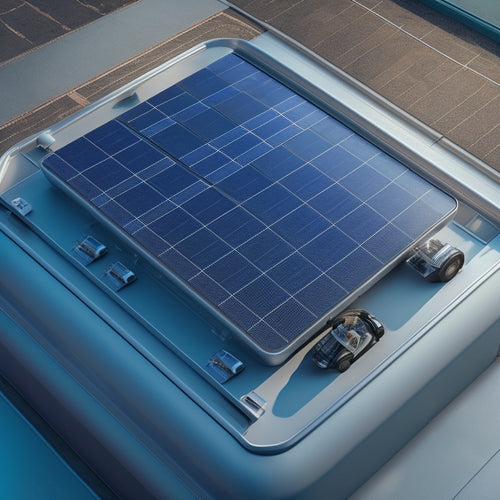
5 Best Ways to Slash Energy Bills With Solar
Share
By investing in solar energy, you can reduce your reliance on non-renewable energy sources and slash your energy bills by up to 50% or more. Five effective ways to do so include harnessing renewable energy sources, maximizing roof space efficiency, reducing peak hour consumption, optimizing energy storage systems, and leveraging net metering incentives. By understanding your energy usage patterns and optimizing your solar panel system, you can maximize your energy production and reduce your energy bills. To tap the full potential of solar energy and discover more strategies to cut your energy costs, explore these methods in more detail.
Key Takeaways
• Harness renewable energy sources like solar panels to reduce reliance on non-renewable energy and cut energy bills.
• Optimize roof space efficiency by strategically positioning solar panels to maximize energy harvesting and reduce energy bills.
• Reduce peak hour consumption by understanding energy usage patterns, rescheduling energy-intensive activities, and using smart plugs and thermostats.
• Implement an optimized energy storage system to reduce reliance on the grid during peak hours and save money on energy bills.
• Leverage net metering incentives by generating excess energy, feeding it back into the grid, and receiving credits on energy bills.
Harnessing Renewable Energy Sources
By incorporating renewable energy sources, such as solar panels or wind turbines, into your home's energy system, you can substantially reduce your reliance on non-renewable energy sources and cut your energy bills.
This shift towards sustainable living not only benefits your wallet but also markedly reduces your carbon footprint.
Renewable energy sources are cleaner and more environmentally friendly, producing little to no greenhouse gas emissions.
With solar panels, for instance, you can generate electricity from sunlight, reducing your dependence on fossil fuels.
In fact, a typical residential solar panel system can save up to 3 tons of carbon dioxide emissions annually.
By harnessing renewable energy, you'll be contributing to a cleaner environment and creating a more sustainable future.
Plus, with government incentives and declining technology costs, the initial investment in renewable energy systems is becoming increasingly affordable.
Take the first step towards a more sustainable lifestyle and consider integrating renewable energy sources into your home's energy system today.
Maximizing Roof Space Efficiency
You can substantially increase the energy-generating capacity of your solar panels by optimizing your roof's spatial layout and strategically positioning panels to maximize energy harvesting.
To do this, you'll need to examine your roof's orientation, which can greatly impact energy production. A south-facing roof with an angle between 15 and 40 degrees is ideal, as it receives the most direct sunlight throughout the day.
Conduct a shading analysis to identify areas of your roof that receive partial shade, which can reduce energy output. You can use tools like solar pathfinders or consult with a solar expert to determine the best panel placement.
Reducing Peak Hour Consumption
Peak hours, typically between 4 pm and 9 pm, account for a substantial portion of your daily energy consumption, and understanding your usage patterns during this time is crucial to reducing your overall energy bills.
You can take advantage of Time of Use (TOU) pricing, which charges you differently depending on the time of day you use energy. By shifting your energy-intensive activities to off-peak hours, you can substantially reduce your energy bills.
Load shifting is another strategy you can employ to reduce peak hour consumption. This involves rescheduling your energy usage to times when energy is cheaper.
For instance, you can program your dishwasher and washing machine to run during off-peak hours. You can also consider installing a smart plug or a smart thermostat to optimize your energy usage during peak hours.
Optimizing Energy Storage Systems
Implementing an optimized energy storage system can substantially reduce your reliance on the grid during peak hours, allowing you to store excess energy generated during the day for later use. This means you'll be less dependent on the grid when energy demand is high, and you'll save money on your energy bills.
To optimize your energy storage system, you'll want to prioritize battery maintenance. Regularly check your battery's state of charge, voltage, and temperature to confirm it's functioning at its best. Proper maintenance will extend the lifespan of your battery and guarantee it's always ready to provide power when you need it.
Optimizing your energy storage system also contributes to grid resiliency. By storing excess energy, you're reducing the strain on the grid during peak hours, making it more reliable and efficient. This not only benefits you but also the entire community. By implementing an optimized energy storage system, you're taking a vital step towards energy independence and a more sustainable future.
Leveraging Net Metering Incentives
By generating more electricity than you consume, your solar panels can feed excess energy back into the grid, and net metering incentives allow you to reap the financial benefits of this surplus.
This is where utility partnerships come into play. By partnering with your utility company, you can take advantage of net metering programs that track the excess energy you produce and provide credits on your energy bill.
With the right metering options, you can accurately measure the excess energy you're producing and selling back to the grid.
When you produce more energy than you consume, your net meter will run backwards, tracking the excess energy you're feeding back into the grid.
This excess energy is then credited to your account, reducing your energy bills. By leveraging these incentives, you can maximize your energy savings and get the most out of your solar investment.
Frequently Asked Questions
How Long Does It Take for Solar Panels to Pay for Themselves?
You'll likely break even on your solar investment within 5-7 years, depending on local solar incentives and your energy usage. A thorough break-even analysis considers factors like installation costs, electricity savings, and tax credits.
Can I Install Solar Panels on a Rented Property?
Before installing solar panels on a rented property, you'll need to review your rent agreement and obtain your landlord's permission, ensuring you're not violating any terms and that they're on board with the installation.
Do Solar Panels Work During Power Outages?
You might wonder if solar panels work during power outages. Unfortunately, they typically don't, as they're grid-tied and shut off during outages for safety and grid resilience reasons. However, you can consider an emergency backup system for continuous power supply.
Are Solar Panels Affected by Weather Conditions Like Hail?
You'll be relieved to know that solar panels are designed with weather resistance in mind, built to withstand harsh storm conditions, including hail, thanks to rigorous testing and certification standards for storm durability.
Can I Use Solar Panels to Charge My Electric Vehicle?
You can charge your electric vehicle with solar panels, and you might even benefit from Vehicle Incentives. As EV Infrastructure expands, you'll have more charging options, making solar-powered EV ownership a convenient, eco-friendly choice.
Related Posts
-

10 Essential Bike Lane Safety Features to Consider
You're designing a bike lane with safety in mind, and that's essential. The National Highway Traffic Safety Administr...
-

Top Solar Panels for Car Battery Maintenance
When selecting top solar panels for car battery maintenance, consider high-efficiency models with high wattage output...
-

3 Best State and Local Solar Incentives USA
You can greatly reduce your energy dependence and save thousands of dollars by taking advantage of the top state and ...


